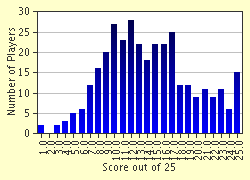Quiz Answer Key and Fun Facts
1. Prelude to the Crusades! The total defeat and capture of this Byzantine Emperor at the Battle of Manzikert (Aug 19, 1071 AD) by Alp Arslan, Seljuk Sultan of Rum, proved to Western monarchs that Byzantium had forfeited the right to be the defenders of the Holy Land. Which Emperor was it?
2. This Byzantine Emperor made the fateful mistake of sending an embassy (March 1095 AD) to Pope Urban II asking for aid from the West to help against the Seljuk Turks. Which Emperor was it?
3. After Pope Urban II had declared a Holy Crusade, a motley collection of lesser nobility and common people launched the so-called 'People's Crusade' in 1095 AD. Which individual was nominally their leader?
4. Before crossing into Imperial territory the 'People's Crusade' stopped in the town of Belgrade (part of the Kingdom of Hungary). A riot between the 'Crusaders' and the Hungarians soon broke out which resulted in the death of about 4000 Hungarians. Which event began the riot?
5. Firuz, after being recently fined by the authorities for blackmarketeering, betrayed this Turkish city to Bohemond, Prince of Taranto (leader of the Norman contingent from southern Italy) on the evening of June 3, 1098 AD. Which city was it?
6. Pope Urban II would not live to hear the news of this city's capture by the First Crusade on July 15, 1099 AD. Which city was it?
7. After this Crusade Leader was declared 'King of Jerusalem' (Jul 17, 1099 AD) he reportedly said 'I will not wear a crown of gold where my master had worn a crown of thorns.' Which individual was it?
8. The fall of this city on December 24, 1144 AD to the Muslims under Zengi, prompted Pope Eugenius III to declare the Second Crusade in 1145 AD. Which city was it?
9. The French Crusaders of the Second Crusade (1147-1149 AD) were led by their king. Which King of France was it?
10. The German Crusaders of the Second Crusade (1147-1149 AD) were led by the Holy Roman Emperor. Which Emperor was it?
11. The French King had taken his wife along on the Second Crusade. She would eventually divorce him and marry a King of England. What was her name?
12. This Muslim leader declared a Islamic Holy War (1187 AD) to crush the Crusader States established in the Holy Land after the First Crusade. Which individual was it?
13. Richard I, the Lion-Hearted, King of England (r. 1189-1199 AD), was one of the famous leaders of the Third Crusade (1189-1192 AD) and a legendary hero in British folklore. Which of the following is NOT true?
14. This French King was the other famous leader of the Third Crusade (1189-1192 AD). During his reign (1180-1223 AD) he would greatly consolidate and strengthen the French monarchy. Which King of France was it?
15. Richard I, King of England, brought the Third Crusade (1189-1192 AD) to a successful conclusion when he forced Saladin to sign a peace treaty giving back the city of Jersalem (captured by Saladin in 1187 AD) to Christendom. True or False?
16. The Fourth Crusade (1202-1204 AD) was primarily led by this Italian maritime power. Which city was it?
17. The first city to fall to the Fourth Crusade (1202-1204 AD) was Zara, a Christian port on the Adriatic Sea. Why?
18. This famous city of the Byzantine Empire fell to the Fourth Crusade (1202-1204 AD) after only a six day siege and was systematically plundered. Which Imperial city was it?
19. The Fifth Crusade (1217-1221 AD) was directed towards the Ayoubid Sultanate of Egypt. The Crusaders would lay siege to the city of Damietta from May 1218-Nov 1219 AD. During the siege which future Saint would act as a mediator between the Christian leaders and Sultan al-Kamil?
20. The Sixth Crusade (1228-1229 AD) was led by this excommunicated Holy Roman Emperor. His prestige (he was known as 'Stupor Mundi' Wonder of the World) quickly gained him a peaceful settlement with Sultan al-Kamil after being in the Holy Land for only five months. Which Emperor was it?
21. The Seventh Crusade (1248-1254 AD) was led by Louis IX, the Saint, King of France, and was once again directed at Egypt. Louis IX was defeated and captured at the Battle of Abu Abdulla (Apr 6, 1250 AD) but was soon released (May 6, 1250 AD) after agreeing to return which recently captured city?
22. The Eighth Crusade (1270 AD) was again led by Louis IX but was directed against Tunis in northern Africa. While laying siege to Carthage (Jul-Aug) what happened to Louis?
23. The Ninth Crusade (1271-1272 AD) was led by Prince Edward of England and accomplished nothing tangible. Edward though would become King of England in 1272 AD and be better known in history as...?
24. This crusade was preached in France and Germany by two young boys (1212 AD) and was not officially sanctioned by Pope Innocent III. It was the Children's Crusade.
25. The Albigensian Crusade (1208-1229 AD) was officially sanctioned by Pope Innocent III (he was very enthusiastic about this crusade). But it was not a crusade to the Holy Land or even to fight Muslims. It was directed at southern France and sought the extinction of which Christian heresy?
Source: Author
hund
This quiz was reviewed by FunTrivia editor
thejazzkickazz before going online.
Any errors found in FunTrivia content are routinely corrected through our feedback system.

